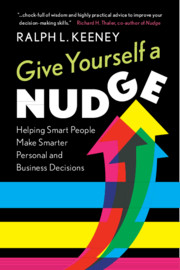Book contents
- Reviews
- Give Yourself a Nudge
- Give Yourself a Nudge
- Copyright page
- Dedication
- Contents
- Preface
- Acknowledgments
- 1 Nudge Yourself to Make Better Decisions
- 2 Your Decisions and Your Life
- 3 Making Value-Focused Decisions
- 4 Defining Your Decision
- 5 Identifying Your Values
- 6 Creating Alternatives
- 7 Identifying Decision Opportunities
- 8 Obtaining Authorization to Select Alternatives Controlled by Others
- 9 Becoming a Value-Focused Decision-Maker
- 10 Enhancing the Quality of Your Life
- 11 Useful Perspectives on Decision-Making
- Appendix Evaluating Alternatives and Making a Decision
- Notes
- Index
6 - Creating Alternatives
Published online by Cambridge University Press: 17 April 2020
- Reviews
- Give Yourself a Nudge
- Give Yourself a Nudge
- Copyright page
- Dedication
- Contents
- Preface
- Acknowledgments
- 1 Nudge Yourself to Make Better Decisions
- 2 Your Decisions and Your Life
- 3 Making Value-Focused Decisions
- 4 Defining Your Decision
- 5 Identifying Your Values
- 6 Creating Alternatives
- 7 Identifying Decision Opportunities
- 8 Obtaining Authorization to Select Alternatives Controlled by Others
- 9 Becoming a Value-Focused Decision-Maker
- 10 Enhancing the Quality of Your Life
- 11 Useful Perspectives on Decision-Making
- Appendix Evaluating Alternatives and Making a Decision
- Notes
- Index
Summary
An alternative is a possible course of action that you have the authority to choose for a decision. Creating alternatives is one of the most important things you can do to make better decisions. The reasons are that you can never select an alternative that you have not identified, and your chosen alternative can be no better than the best of those that are identified. Numerous studies indicate that decision-makers have many shortcomings in creating alternatives, mainly because they do not spend any, or enough, time creating alternatives and they are relatively ineffective spending the time that is allocated. Thinking outside the box is useful advice, but it gives no guidance on how to create desirable alternatives. You want to think inside a much larger, right-sized alternatives box. Your values for a decision are the key to creating better alternatives, as alternatives are subsequently evaluated in terms of these values. A systematic process is provided for using values to create innovative and better alternatives. Practical experiments that show the effectiveness of this process are presented. The concept of value-focused brainstorming to create innovative alternatives in groups is presented and its usefulness is demonstrated in a major application.
Keywords
- Type
- Chapter
- Information
- Give Yourself a NudgeHelping Smart People Make Smarter Personal and Business Decisions, pp. 80 - 116Publisher: Cambridge University PressPrint publication year: 2020



